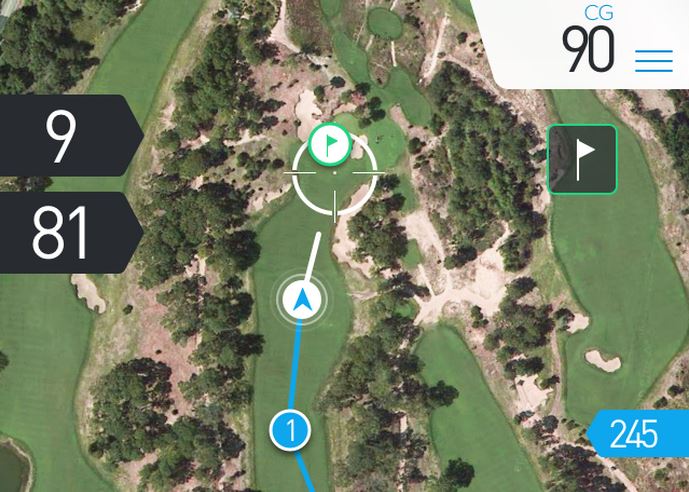Robert is a shot tracking expert, so much so he wanted to share his own manifesto with Breaking Eighty. We’re always happy to accept guest posts from guys like Robert, so take it away!
The last couple years have seen a good deal of discussion about technology’s effects upon golf as a culture and as an commercial industry, about the adoption of ‘golf-tech’ products, and golf-tech’s potential in both of these regards.
Being a golfer myself, I think the ability to track your round shot-by-shot is one of the coolest features golf-tech has unlocked for us thus far.
There are a couple consumer realities right now that make this topical.
The first reality is that many golfers don’t realize this ability to track shots is readily available to them. The second is that those who are aware of products that track shots (from Game Golf and Arccos Golf on the hardware side, to Hole19Golf and others on the software side) are largely under-informed about the benefits of shot-tracking to their golf game.
Benefits of Stats Tracking
By tracking your round shot-by-shot, you also track your stats.
“Why golfers should track their stats” is a whole discussion in and of itself, but suffice to say there’s a reason all the pros know theirs.
The reason is simple: knowing what you do well and what you do less well is the first step to improving.
Instead of practicing in “scattershot mode” (doing a little bit of everything whenever you feel like it), knowing your stats helps you easily identify the areas where you are weakest, and the areas when you can save the most shots.
In this way, your stats serve as a guide for the breakdown of your practice time. Stats also help instructors by indicating what is actually happening with a player on the course, giving context to what the instructor may be seeing in a player on the driving range.
Here’s a simple example of stats easily guiding me to the type of practice I need: if I see my ‘Overall Putts/Hole’ is 1.8 but my ‘Putts/GIR’ is 2.2, that probably means I have lead hands or need to work on my lag putting (or both).
Another example: If my ‘FW Hit %’ with my driver is 38% and is 62% with my 3-wood, I probably have been watching too many John Daly YouTube videos, need to work on my Driver accuracy, and ought to look for opportunities to substitute in 3-wood for Driver during rounds.
Set Better (and More Attainable) Goals
Another key reason golfers should track and know their stats is that stats help you set challenging yet attainable goals.
With stats, you can break down big goals (breaking eighty, achieving a scratch handicap) into smaller, bite-sized goals (bring my ‘FW Hit %’ from 47% to 55% over the next 5 rounds).
There is plenty of research indicating that goal-setting promotes improvement.
But perhaps the best aspect of these mini “stat goals” is that you can recognize small wins (baby steps), the building blocks of lasting improvement. Psychologically, this helps you feel like you are getting better and reinforces you with vigor to continue your pursuit of your bigger goals.
Immediate Feedback
You get immediate feedback on how far you hit your shots.
They joy of adding a stroke and seeing “326” (as in yards of the drive I just hit) record immediately on your screen is fantastic.
Gale force wind at your back in Ireland? Doesn’t matter – showing 326 is awesome.
At a rock-hard muni in Nebraska? Still awesome.
3 giant bounces off the cart path? Can’t wait to share with my buddies.
Off a cliff above the treetops in Northern Michigan? My favorite.
Juiced with adrenaline on the final hole of the Club Championship? You bet I want to know.
Regardless of the conditions, when you crush a drive, you want to know how far it went. Tracking your shots gives you the ability to know exactly that (and then brag about it!).
But it’s also interesting to see distance-traveled on other shots.
Take into-the-wind shots as an example: I want to know how much the wind affects my shots. If I hit my driver pure in this wind, how much is it restricted? 15%?
Okay, then when I hit my 8 iron pure into this wind, how much is it restricted? 25%? I can get real answers to these questions when I track my shots. The same goes for when I experiment hitting punch shots. Or shots with a ‘¾’ swing.
How Far Are You Actually Hitting the Ball?
A third shot-tracking benefit that may seem obvious but is too often overlooked is simply zeroing in on how far you hit each club.
This is ‘Playing Golf 101’, but a lot of people don’t know!
Some have a vague range. Others have a maximum in their head from that one time they crushed their shot downwind off a cliff. Some hold a number in mind that applied to their game 3 years ago.
Tracking all your shots helps you discover your actual values, helping your decision making on the course and hopefully relieving you of the feeling of the need to “max out” every shot to achieve the distance you have in mind.
Reviewing Your Game, After the Fact
You can go back and relive your round after the fact.
Tracking your rounds shot-by-shot using a modern on-course technology companion gives you the ability to access that round at any time.
That allows you to share your round in a physical, visual way via social networks. It then becomes a reference point for online conversation amongst friends, family and colleagues.
Every golfer loves to tell their friends about the stand-out shots they played, good and bad, after their round. Having the visual of every shot of your round inevitably drives lots of fun commentary and BS’ing:
“How do you possibly go that far left on 9?!”
“Mack didn’t get past the ladies’ tee! Did your club go further than the ball?”
“He choked on 18 because he knew he had a chance to break 90!”
“Look at this guy making a birdie-birdie finish- from the back tees! What a stud!”
“How do you only hit 2 fairways and still shoot 75?! Were you using a pink driver?”
Obviously it’s just as useful and fun as a reference point as you narrate your round to your friends at the bar or on the couch after the round. The physical shots are there with distances traveled and clubs hit- then it’s up to you to fill in the color.
Besides being a reference point for conversation about the round, past tracked rounds can serve as helpful course management aids.
Say you’re playing a course you haven’t played in a while. Being able to pull up the last round you played on it 8 months ago allows you to recall some key course management tips you may have learned from the last time(s) you played the course.
These could be aiming points, shot types that are most suitable, clubs to hit off the tee, “off-limits” zones, or green breaks that you only know from experience. It’s like a yardage book, but the notes are your actual shots overlaid onto each hole.
So you see, Shot Tracking is about having fun and getting better…if that’s not enough for you then…well, you’re not invited to my birthday party.
Robert works for Hole19 Golf. The free app gives you access to distances, hole maps, scorekeeping, stat-tracking, and shot-tracking on over 28,000 courses worldwide. Available on iOS and coming soon to Android!

